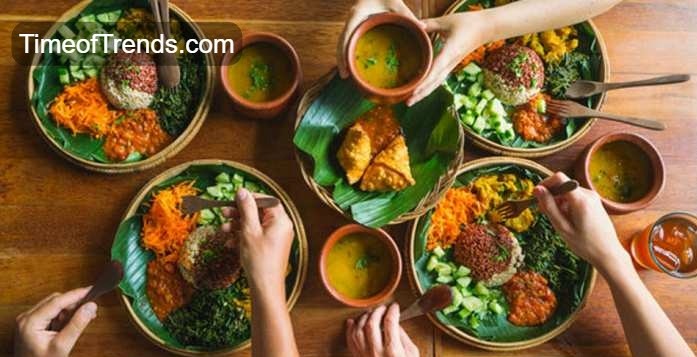The Ultimate Guide to Wellhealthorganic.com:ayurveda-dinner
Are you looking for a way to enhance your well-being through your dinner choices? Look no further than Ayurveda, an ancient Indian system of medicine that focuses on balancing the mind, body, and spirit. With its emphasis on fresh ingredients and mindful eating practices, Ayurvedic cuisine offers a holistic approach to nourishing your body. In this ultimate guide to Ayurveda dinner, we’ll explore the three doshas, cooking methods, six tastes, and how to balance your doshas with delicious recipes. Get ready for a journey into the world of Ayurvedic dining!
What is Ayurveda?
Ayurveda is a holistic system of medicine that originated in India over 5,000 years ago. The word “Ayurveda” comes from the Sanskrit words “ayur,” meaning life, and “Veda,” meaning knowledge. It is based on the idea that everything in the universe is interconnected, including our thoughts, emotions, and physical bodies. At its core, Ayurveda focuses on maintaining a balance between three doshas: Vata (air and space), Pitta (fire and water), and Kapha (earth and water). Each person has a unique combination of these doshas which determine their physical characteristics as well as their mental and emotional qualities.
The goal of Ayurvedic treatments is to restore balance to the body by addressing imbalances within each individual’s dosha composition. This can be achieved through various practices such as diet modifications, herbal remedies, meditation techniques or yoga. Ayurvedic practices promote self-awareness while encouraging individuals to take an active role in their own health journey. By understanding one’s constitution type or Dosha combination., people are able to make informed decisions about how they nourish themselves physically , mentally , emotionally leading towards overall wellness .
The Three Doshas
Ayurveda is based on balancing the three doshas, which are the fundamental energies that govern our physical and mental processes. The three doshas are known as Vata, Pitta, and Kapha.
Vata is associated with movement and creativity. It governs breathing, blood circulation, muscle activity, and heartbeat. People with dominant Vata tend to have a thin build, dry skin, cold hands and feet, and difficulty gaining weight.
Pitta is related to metabolism and transformation. It governs digestion, absorption of nutrients from food into tissues or cells among other things. People with dominant Pitta tend to have a medium build with warm body temperature.
Kapha relates to structure or stability within the body. It governs growth of muscles,kidney functions,respiratory system etc.
People who possess more kapha qualities often have a larger frame or heavier bone structure along with cool body temperature. Knowing your predominant dosha can help you choose foods that will balance it out for optimal health benefits in Ayurvedic cooking methods. The key concept here is achieving balance between all three Doshas rather than eliminating one completely
Ayurvedic Cooking Methods
Ayurvedic cooking methods are one of the most important aspects of Ayurveda. These methods ensure that you prepare your food in a way that enhances its nutritional value and makes it easy to digest.
The primary Ayurvedic cooking method is the use of spices, which not only add flavor but also have medicinal properties. In Ayurveda, it’s believed that each spice has unique healing qualities and when used correctly can help balance your doshas.
Another essential aspect of Ayurvedic cooking is mindful preparation. This means taking time to connect with your food by washing, chopping, and preparing it with intention and gratitude.
Cooking methods such as steaming, boiling or sautéing with ghee or coconut oil are preferred over frying in unhealthy oils. The goal is to cook your food gently without losing any vital nutrients while making it easier for your body to break down during digestion.
In addition, Ayurvedic cooking emphasizes seasonal eating. It’s recommended to eat foods that grow naturally during each season since they contain the right nutrients needed at specific times of the year. By following these simple yet powerful techniques for preparing meals, you’ll be able to experience improved digestion and overall well-being through an Ayurveda diet plan like what Well Health Organic offers in their ayurveda dinner meal kit options!
The Six Tastes
Ayurveda considers six tastes that are important for maintaining balance in the body. Each taste has its own unique qualities and can affect the doshas differently.
The first taste is sweet, which is known to be grounding and nourishing. It helps pacify Vata and Pitta doshas but can increase Kapha if consumed excessively. Sour taste stimulates digestion and metabolism, making it useful for balancing Kapha dosha. However, consuming too much of sour foods can aggravate Pitta dosha.
Salty taste adds flavor to food while also stimulating digestion and elimination. It’s beneficial for Vata due to its grounding nature, but excessive salt intake can worsen both Pitta and Kapha imbalances. Pungent taste provides warmth to the body while promoting digestive fire. It’s best suited for individuals with a predominantly Kapha constitution as it helps improve their sluggish digestion.
Bitter taste has a cooling effect on the body while helping detoxify any accumulated toxins in the system. Bitter foods help reduce excess heat in Pitta individuals but may aggravate Vata if taken too much or not balanced properly with other tastes. Astringent taste causes contraction of bodily tissues resulting in dryness and roughness. This makes it beneficial for reducing excess moisture present in an individual’s body who has a predominant Kapha constitution; however, taking excessive amounts may cause drying out skin or hair leading towards imbalance.
How to Balance Your Doshas with Dinner
When it comes to Ayurveda, balancing your doshas is essential for maintaining good health. Dinner time is a great opportunity to balance your doshas and improve overall well-being.
To balance your doshas with dinner, start by identifying which of the three doshas you need to pacify. If you are feeling anxious or stressed, you may have an excess of Vata. Alternatively, if you feel angry or irritable, Pitta may be dominating. Once you know which dosha needs balancing, choose foods that will help pacify it. For example, if you have excess Vata, opt for warm and grounding foods such as root vegetables or soups cooked with warming spices like ginger or cinnamon.
If Pitta is dominant in your body at dinnertime, cool and refreshing foods can help bring balance. Try incorporating cooling herbs like cilantro and mint into dishes along with fresh fruits like watermelon or pomegranate. For those who struggle with Kapha imbalances such as sluggishness or weight gain at dinner time , light and spicy food choices are recommended . Adding a pinch of digestive spices like cumin powder to meals can also aid digestion .
By selecting the right ingredients for your body’s current state ,you create an opportunity not just for nourishment but also healing through food . Incorporating this knowledge into preparing our meals could prove a very effective tool towards achieving optimal health!
Ayurvedic Recipes
Ayurvedic recipes combine ingredients that are believed to balance the doshas and promote wellness. One popular dish is kitchari, a nourishing rice and lentil stew with warming spices like ginger, cumin, and turmeric. It’s easy to customize by adding vegetables or protein.
Another delicious Ayurvedic recipe is golden milk, a soothing drink made with almond milk and anti-inflammatory spices like cinnamon, cardamom, and black pepper. Sipping on this before bed can help promote restful sleep.
If you’re looking for something sweet, try making date balls with nuts and seeds. Dates are rich in minerals while nuts provide healthy fats and proteins. These energy balls make great snacks throughout the day! In Ayurveda, it’s also important to eat seasonal foods as they are believed to be most beneficial during their natural harvest time. So try incorporating fresh fruits and veggies into your meals whenever possible!
Conclusion – Wellhealthorganic.com:ayurveda-dinner
Wellhealthorganic.com:ayurveda-dinner is a holistic approach to well-being that focuses on balancing the mind, body, and spirit. By understanding your dosha type and incorporating Ayurvedic cooking methods and foods into your dinner routine, you can enhance your overall health and well-being. Remember to listen to your body’s signals and make adjustments accordingly. It may take some time to find the right balance for you, but with patience and consistency, you can reap the benefits of an Wellhealthorganic.com:ayurveda-dinner lifestyle.
Try out some of the Ayurvedic recipes provided in this guide or explore other options available online or through an Ayurvedic practitioner. With dedication and mindfulness towards what we put in our bodies during dinner time specifically as recommended by Well Health Organic’s ayuerveda dinner guide – we can achieve better digestion, boost immunity levels while also improving mental clarity & physical energy levels. Embrace the wonders of Ayurveda today!

